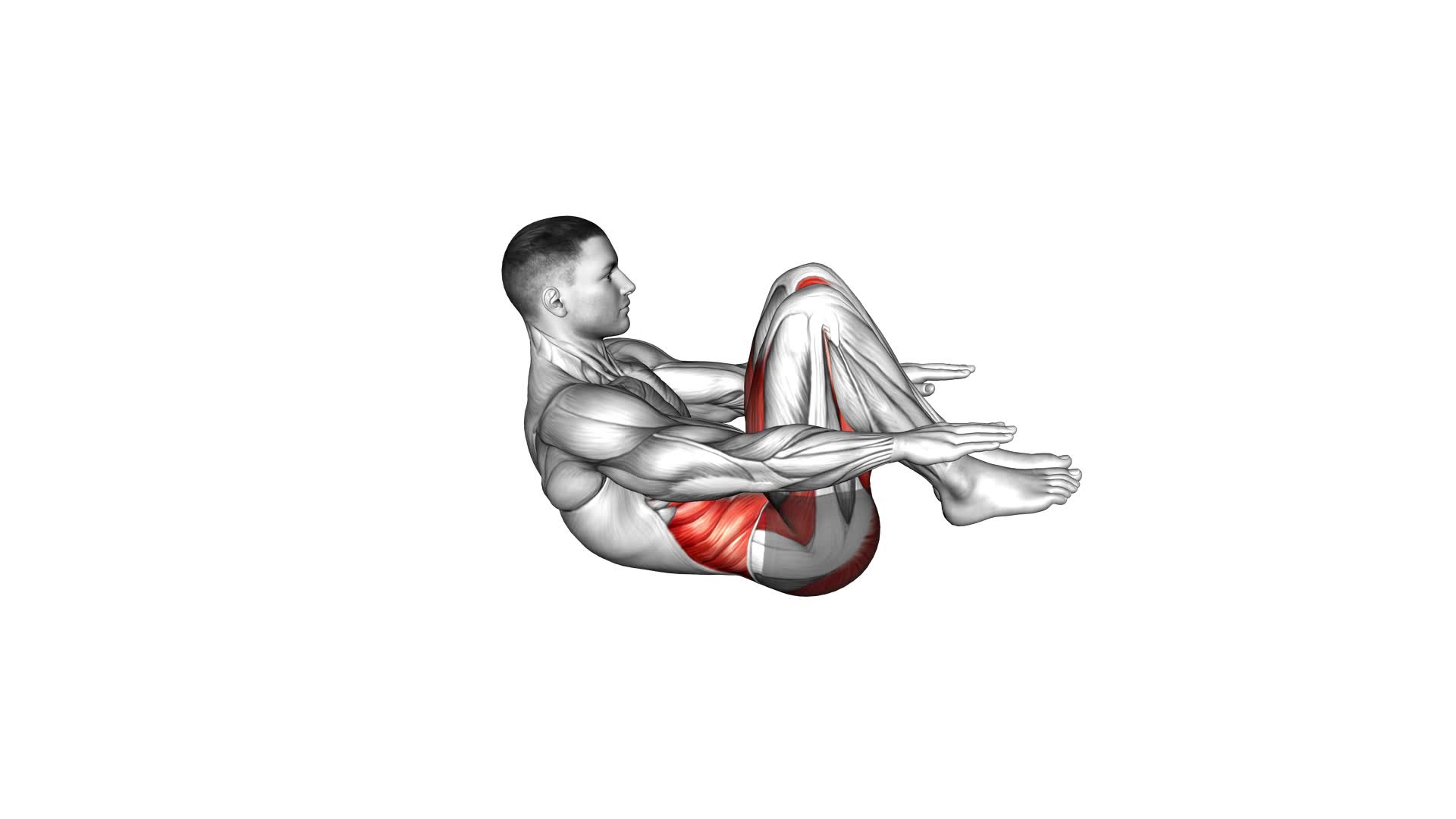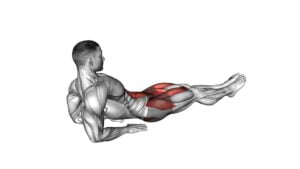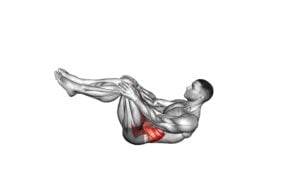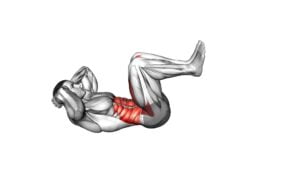Lying Tuck-up (male) – Video Exercise Guide & Tips

Are you looking to strengthen your core and build those abdominal muscles? Look no further than the lying tuck-up exercise!
Watch This Exercise Video
In this video exercise guide, we will walk you through the proper form and technique, common mistakes to avoid, modifications for beginners, and advanced variations for experienced trainers.
With these tips and tricks, you'll be on your way to maximizing your results and achieving your fitness goals. Get ready to feel the burn and transform your core with the lying tuck-up.
Key Takeaways
- Improved core strength and stability
- Targeted abdominal muscle definition and strength
- Engagement of lower back and hip muscles for balance and stability
- Comprehensive activation of multiple muscle groups
Benefits of the Lying Tuck-up
You will experience improved core strength and stability through regular practice of the Lying Tuck-up. This exercise specifically targets your abdominal muscles, helping to increase their definition and overall strength. By engaging your core and lifting your legs off the ground while lying on your back, you're challenging your abdominal muscles to work harder and become stronger.
The Lying Tuck-up is highly effective in improving core strength because it requires you to stabilize your body while performing the movement. This means that not only are you working your abs, but you're also engaging your lower back and hip muscles, which are essential for maintaining balance and stability. As you continue to practice this exercise, you'll notice an increase in your core strength, making everyday activities like lifting objects or maintaining good posture much easier.
Furthermore, the Lying Tuck-up is a compound exercise, meaning it works multiple muscle groups simultaneously. In addition to your abdominals, your hip flexors, quads, and glutes are also engaged during this movement. This comprehensive activation of muscles leads to a more efficient workout and faster results in terms of core strength and abdominal muscle definition.
Proper Form and Technique
How can you ensure proper form and technique for the Lying Tuck-up exercise?
To perform the Lying Tuck-up with proper form and technique, it's important to understand and address common misconceptions and focus on the importance of proper breathing.
One common misconception is that the Lying Tuck-up only targets the abdominal muscles. While it does primarily engage the abs, it also works the hip flexors and lower back. To ensure proper form, start by lying flat on your back with your arms extended overhead. As you lift your legs and torso simultaneously, exhale and contract your abdominal muscles, aiming to bring your knees and chest close together. Inhale as you lower your legs and torso back down to the starting position.
Proper breathing is crucial during the Lying Tuck-up exercise. Exhaling during the exertion phase, when you lift your legs and torso, helps engage and activate your core muscles more effectively. Additionally, maintaining a steady and controlled breath throughout the exercise promotes stability and prevents unnecessary strain on your body.
Common Mistakes to Avoid
To ensure proper form and technique for the Lying Tuck-up exercise, it's important to be aware of common mistakes that should be avoided. By avoiding these mistakes, you can maximize your results and prevent injury.
One common mistake to avoid is using momentum to lift your legs instead of engaging your core muscles. This can reduce the effectiveness of the exercise and put unnecessary strain on your lower back. To maximize your results, focus on using your abdominal muscles to lift your legs and maintain control throughout the movement.
Another mistake to watch out for is lifting your head and neck too high off the ground. This can strain your neck and lead to discomfort or injury. Instead, aim to keep your head and neck in a neutral position, with your chin slightly tucked in towards your chest.
Finally, be mindful of your breathing. It's common to hold your breath during challenging exercises, but this can restrict oxygen flow and make the exercise more difficult. Remember to breathe steadily throughout the movement.
Modifications for Beginners
To make the Lying Tuck-up exercise more accessible for beginners, a modification can be implemented. Here are some beginner modifications for the Lying Tuck-up:
- Start with a partial tuck-up: Instead of fully lifting your upper body off the ground, begin by lifting your shoulders only. This reduces the intensity of the exercise and allows you to build strength gradually.
- Use a stability ball: Place a stability ball under your lower back for added support. This helps to decrease the strain on your core muscles and makes the exercise more manageable for beginners.
- Bend your knees: Rather than keeping your legs straight, bend your knees and keep your feet flat on the ground. This modification reduces the demand on your core muscles and makes the exercise easier to perform.
- Use your hands for support: If you're finding it challenging to lift your upper body off the ground, you can place your hands behind your head for support. This provides extra assistance and makes the exercise less demanding.
- Take breaks: If you're struggling to maintain proper form or feel fatigued, it's important to listen to your body and take breaks as needed. This allows you to gradually build strength and avoid overexertion.
Advanced Variations for Experienced Trainers
Now that you're an experienced trainer, it's time to take your lying tuck-ups to the next level with some advanced variations.
Unilateral exercises, such as single-leg tuck-ups, can challenge your core stability and balance even further.
Additionally, incorporating progressive overload techniques, like adding weights or increasing the difficulty of the movement, will help you continue to make gains and push your limits.
Remember to always listen to your body and progress at a pace that's challenging yet safe.
Unilateral Exercises for Pros
For advanced trainers, incorporating unilateral exercises into your routine can greatly enhance your strength and stability. Unilateral strength training focuses on working one side of your body at a time, which helps to correct muscle imbalances and improve overall symmetry. Here are five advanced variations of unilateral exercises that experienced trainers can try:
- Bulgarian Split Squats: This exercise targets your quads, hamstrings, and glutes while challenging your balance.
- Single-Leg Deadlifts: By engaging your core and working your hamstrings and glutes, this exercise improves stability and strengthens your posterior chain.
- Single-Arm Dumbbell Rows: This exercise targets your back muscles, helping to improve posture and upper body strength.
- Single-Leg Step-Ups: This exercise targets your quads, hamstrings, and glutes while improving balance and stability.
- Single-Arm Overhead Press: By working your shoulders, triceps, and core, this exercise improves upper body strength and stability.
Incorporating these unilateral exercises into your routine will help you take your training to the next level and achieve optimal performance.
Progressive Overload Techniques
As an experienced trainer, you can further enhance your strength and stability by incorporating progressive overload techniques into your routine.
These advanced variations are designed to push your weightlifting progress and maximize muscle building techniques.
One effective method is to increase the weight you lift gradually over time. This can be done by adding small increments of weight to your exercises, challenging your muscles to adapt and grow stronger.
Another technique is to increase the number of repetitions or sets you perform. By gradually adding more volume to your workouts, you can stimulate further muscle growth and increase your overall strength.
Additionally, you can decrease the rest time between sets, forcing your muscles to work harder and promoting greater gains.
Remember to always listen to your body, progress at a pace that feels comfortable, and consult with a professional trainer if needed.
Tips for Maximizing Your Results
To maximize your results with the lying tuck-up exercise, it's crucial to focus on proper form techniques. This means maintaining a strong core and engaging your abdominal muscles throughout the movement.
Additionally, efficient workout strategies, such as incorporating variations and increasing intensity gradually, can help you see progress faster.
Remember to prioritize recovery and rest days to allow your muscles to repair and grow stronger.
Proper Form Techniques
Maximize your results with proper form techniques for the lying tuck-up exercise. By focusing on proper form, you can ensure that you're targeting the right muscles and avoiding any potential injuries. Here are some tips to help you perform the lying tuck-up exercise with proper form:
- Start by lying flat on your back with your arms extended overhead.
- Engage your core muscles and lift your legs and upper body simultaneously, bringing your knees towards your chest and reaching your hands towards your toes.
- Maintain a controlled and slow movement throughout the exercise, avoiding any jerking or swinging motions.
- Exhale as you bring your knees towards your chest and inhale as you return to the starting position.
- Keep your lower back pressed firmly against the ground to prevent any strain on your spine.
By following these proper form techniques, you can maximize the benefits of flexibility and core strength that the lying tuck-up exercise offers.
Now, let's move on to efficient workout strategies to help you make the most out of your exercise routine.
Efficient Workout Strategies
To get the most out of your lying tuck-up workout, it's important to incorporate efficient strategies that will help you achieve optimal results.
One effective strategy is circuit training, which involves performing a series of exercises back-to-back with little to no rest in between. This not only saves time but also increases the intensity of your workout, leading to greater calorie burn and muscle activation.
Another time-saving exercise to consider is compound movements, which work multiple muscle groups simultaneously. Examples include squats, lunges, and push-ups. By incorporating these exercises into your routine, you can maximize your workout efficiency and target multiple areas of your body at once.
Remember to always prioritize proper form and technique to avoid injury and ensure optimal results.
Recovery and Rest Days
How can you effectively maximize your results through recovery and rest days?
Recovery and rest are crucial for achieving optimal results in your fitness journey. Here are some key strategies to help you make the most out of your rest days:
- Prioritize sleep: Get enough quality sleep to allow your body to repair and rejuvenate.
- Active recovery: Engage in light activities like walking or stretching to promote blood flow and reduce muscle soreness.
- Proper nutrition: Fuel your body with nutritious meals and snacks to support muscle recovery and growth.
- Hydration: Drink plenty of water to stay hydrated, aid in digestion, and flush out toxins.
- Mental relaxation: Take time to unwind and destress through activities like meditation or hobbies.
Frequently Asked Questions
Can Lying Tuck-Ups Help Me Lose Belly Fat Specifically?
Lying tuck-ups can be effective for overall weight loss, including reducing belly fat. By engaging your core muscles, this exercise helps to strengthen and tone your abdominal area. To maximize results specifically for belly fat reduction, make sure to maintain proper form throughout the exercise and focus on contracting your abs.
Additionally, incorporating healthy eating habits and regular cardio exercise into your routine will further support your goals of losing belly fat.
How Many Repetitions of Lying Tuck-Ups Should I Aim for in Each Workout?
To maximize the effectiveness of your workout, it's important to set a goal for the number of repetitions of lying tuck-ups. The right amount will depend on your fitness level and the intensity of your workout.
Aim to challenge yourself without sacrificing proper form. Start with a manageable number and gradually increase as you get stronger.
Can Lying Tuck-Ups Help Improve My Posture?
Lying tuck-ups, a great exercise for core strength, can also help improve your posture. By engaging your core muscles, these exercises can strengthen your abdominal and back muscles, which play a crucial role in maintaining good posture.
Additionally, lying tuck-ups offer multiple benefits for overall fitness, such as improving stability, increasing flexibility, and enhancing your body's overall strength.
Incorporating lying tuck-ups into your workout routine can contribute to better posture and overall fitness.
Is It Necessary to Use a Mat or Any Equipment for Performing Lying Tuck-Ups?
Matless lying tuck-ups can still be effective in improving your posture. While using a mat or equipment can provide additional support and stability, it isn't necessary for performing this exercise.
The benefits of equipment-free lying tuck-ups include increased core strength, improved spinal alignment, and enhanced overall body stability. By engaging your abdominal muscles and focusing on proper form, you can achieve great results even without the use of any equipment.
Can Lying Tuck-Ups Be Incorporated Into a Full-Body Workout Routine?
Lying tuck-ups can definitely be incorporated into a full-body workout routine. They're a great exercise for building core strength and targeting your abs. Compared to traditional crunches, lying tuck-ups are more effective because they engage not only your abdominal muscles but also your hip flexors and lower back.
If you're a beginner or have lower back pain, you can modify lying tuck-ups by keeping your feet on the ground and focusing on lifting your shoulders off the mat.
Conclusion
In conclusion, the lying tuck-up is a highly beneficial exercise that targets the core muscles. By practicing proper form and technique, you can avoid common mistakes and maximize your results.
Beginners can modify the exercise to suit their fitness level, while experienced trainers can try advanced variations to challenge themselves further.
By following these tips, you can achieve a stronger core and improve your overall fitness. Keep up with your workouts and enjoy the benefits of the lying tuck-up.

Author
Years ago, the spark of my life’s passion ignited in my mind the moment I stepped into the local gym for the first time. The inaugural bead of perspiration, the initial endeavor, the very first surge of endorphins, and a sense of pride that washed over me post-workout marked the beginning of my deep-seated interest in strength sports, fitness, and sports nutrition. This very curiosity blossomed rapidly into a profound fascination, propelling me to earn a Master’s degree in Physical Education from the Academy of Physical Education in Krakow, followed by a Sports Manager diploma from the Jagiellonian University. My journey of growth led me to gain more specialized qualifications, such as being a certified personal trainer with a focus on sports dietetics, a lifeguard, and an instructor for wellness and corrective gymnastics. Theoretical knowledge paired seamlessly with practical experience, reinforcing my belief that the transformation of individuals under my guidance was also a reflection of my personal growth. This belief holds true even today. Each day, I strive to push the boundaries and explore new realms. These realms gently elevate me to greater heights. The unique combination of passion for my field and the continuous quest for growth fuels my drive to break new ground.







